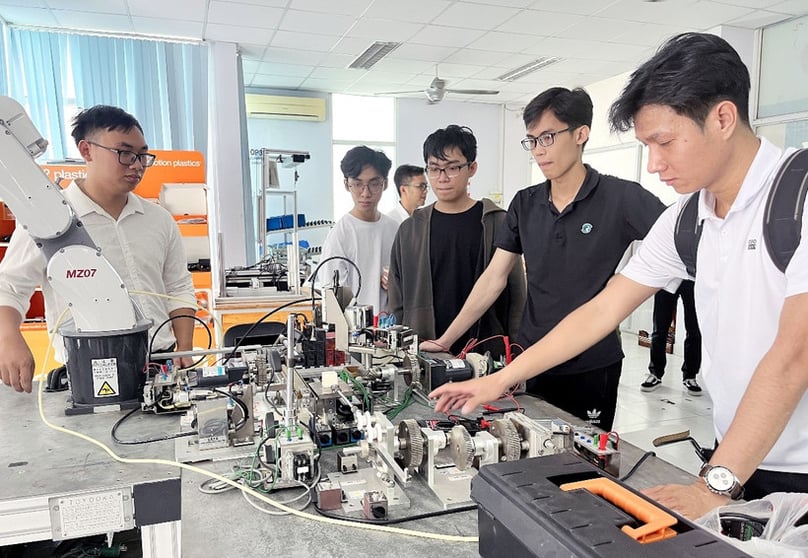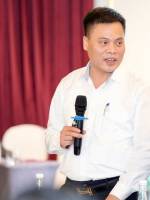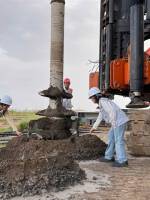
Vietnam is well prepared in terms of infrastructure, but to capture the semiconductor investment wave, it must address the challenges of clean energy and highly-skilled labor, said Tran Tan Sy, deputy CEO of KN Holdings, a leading multi-sector group in Vietnam.
Speaking at a forum on industrial property on Wednesday, Sy said that for investors from Taiwan and the U.S., power supply and technical workforce are the two decisive factors when choosing a destination.
Vietnam is moving in the right direction, but these remain key challenges that must be resolved soon to capture the incoming wave of high-tech investment, he noted.
Vietnam’s industrial infrastructure, particularly in the southern region, has made significant strides. In Dong Nai, where KN Holdings is heavily investing in industrial park and logistics infrastructure, the connectivity network is becoming increasingly complete.
Major projects such as expressways, ring roads, and especially Long Thanh International Airport – set to begin commercial operations in early 2026 – are expected to create a new growth hub for the global supply chain.
Sy said Vietnam’s hard infrastructure is ready and the country now has the capacity to meet investment demand, but energy and human resources still need stronger reinforcement.
The challenge lies in the scale of training, he said, suggesting that partnering with international universities could help address this gap.
Under Vietnam’s human resources development program for the semiconductor industry to 2030, with a vision to 2050, the country aims to train at least 50,000 semiconductor engineers, including 15,000 in chip design and 35,000 in manufacturing and packaging by 2030.
Beyond human resources, energy is also a critical issue – not just in terms of availability, but cleanliness, Sy said, noting that clean energy is a prerequisite for global corporations to meet their net-zero emission targets.
KN Holdings currently operates 200 MW of solar power in Khanh Hoa province and has recently signed a partnership with Samsung to develop 800 MW of floating solar projects in the Central Highlands and Tri An Lake, as part of a master plan approved by the Prime Minister with a total capacity of 2,700 MW.
KN Holdings has invested in and put into operation three large-scale solar power plants in Khanh Hoa, central Vietnam – KN Cam Lam, Cam Lam VN, and KN Van Ninh – covering more than 255 hectares, with a total investment of VND4.3 trillion ($163.44 million) and a combined capacity of 200 MWp. The facilities generate about 320 million kWh of clean electricity annually, helping cut more than 299,000 tons of CO2 emissions.
In August, KN Holdings signed an MoU with Samsung C&T to implement three floating solar power projects at the KN Srepok 3, KN Ialy Gia Lai, and KN Ialy Kon Tum hydropower reservoirs, with a total planned capacity of 864 MW.
The projects will adopt the Direct Power Purchase Agreement (DPPA) mechanism, giving priority to supplying clean electricity to large consumers. This will help reduce greenhouse gas emissions, promote the use of renewable energy, and contribute to Vietnam’s green energy transition goals, the company said.
According to Dato’ Ir. Ts. Razib Dawood, executive director of the ASEAN Center for Energy (ACE), Vietnam, along with Laos and Myanmar, stands out in the region for its diverse renewable energy resources.
Vietnam’s clear geographical advantage lies in its strong wind potential for both onshore and offshore wind power development, he told the press on the sidelines of the Singapore International Energy Week 2025 (SIEW), held from October 27 to 31.
Meanwhile, International Energy Agency (IEA) executive director Fatih Birol said he expects to see strong growth in solar power in Vietnam, Indonesia, and Thailand, describing them as the most promising markets in the region.
Vietnam is completing procedures to become an official member of the International Renewable Energy Agency (IRENA) – an intergovernmental organization supporting countries in their transition to a sustainable energy future.
Vietnam is now home to more than 50 chip design firms employing an estimated 7,000 engineers. Around 15 companies with some 6,600 engineers and over 10,000 technicians are engaged in chip packaging, testing, and production of semiconductor equipment and materials, according to the Ministry of Industry and Trade.
The country has issued a standardized curriculum for semiconductor education. A total of 166 universities now offer semiconductor-related programs, with over 6,300 undergraduate students majoring directly in semiconductors and more than 12,000 studying related fields.
As of August 2025, the country had around 170 FDI projects in the semiconductor and high-tech sectors, with total registered capital of nearly $11.6 billion.
Chau Anh




